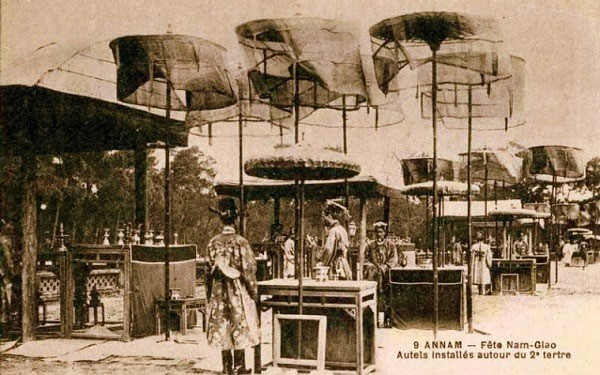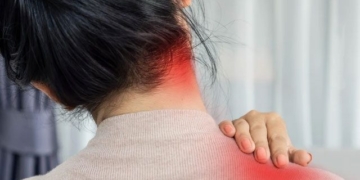On the first day of the New Year, the kings of ancient Vietnam often conducted many important national ceremonies.
The first day of the Lunar New Year (Tết Nguyên Đán) marks the beginning of a new year. According to surviving historical documents, from the early days of independence, the kings of Vietnam paid great attention to the rituals on the first day of the new year.
The Dynasties of Đinh, Lê, Lý, and Trần
During the Đinh, Lê, Lý, and Trần dynasties, on the eve of Tết (the 30th of the last lunar month), the king would sit at the Đoan Củng gate, where officials would come to perform rituals and watch traditional performances. In the evening, the king would visit the Động Nhân palace to pay respects to his ancestors. That night, a monk would enter the royal inner sanctum to perform the “Khu Na” ritual, which was meant to drive away evil spirits.
On the first day of Tết, around the fifth watch (3 AM – 5 AM), the king would sit on the Vĩnh Thọ throne, with his descendants and close officials performing the initial rituals before entering the Trường Xuân palace to pay homage to the royal tomb.

New Year ceremony in ancient royal courts.
In the early morning, the king would sit on the Thiên An throne, with the concubines arranged in rows below, and the officials standing in front of the throne. Music would be played in front of the grand hall. The king’s descendants and officials would line up to pay their respects, pouring wine three times as offerings.
After the rituals were completed, the royal descendants would attend the banquet. The inner officials would sit on either side to partake in the feast, and by noon, they would gradually return home. The first day’s rituals of the new year would conclude.
The New Year’s Day of the Lê and Trịnh Dynasties
During the Lê – Trịnh period, the real power was not held by King Lê but by Lord Trịnh and the crown prince. However, during the New Year festivities, King Lê was still regarded as the presiding figure for important court ceremonies. Lord Trịnh would still engage in activities demonstrating loyalty to the Lê kings.
On the morning of the first day of Tết, the Chief of the Trịnh court (the eldest son of Lord Trịnh) would lead the officials and generals in formal attire to greet King Lê and perform the New Year’s congratulatory ceremony.
The day before, the Department of Ceremonies had set up the royal seat at the Kính Thiên throne and arranged the offering table. The Department of Music prepared the ceremonial music, with grand music presented in the East-West dragon courtyard. The Department of Guards arranged flags and weapons according to the protocol.
In the main hall, the Department of Rites and the Department of Ceremonial Affairs set up a table, where the petition from the general of the capital was placed. The Chief Minister and the Department of Justice congratulated the king.
The officials from the Department of Rites and the Department of Ceremonial Affairs stayed overnight in the main hall, waiting until close to the fifth watch to bring the petition into the palace, covered with a golden canopy, with flags, drums, and music preceding, followed by civil and military officials. The Department of Ceremonial Affairs carried the petition to the Đoan Môn gate, placing it at the eastern side of the dragon courtyard.
The ceremonial drum sounded for the first time, and officials lined up outside the Đoan Môn gate. The drum sounded a second time, and the ceremonial officer led the Chief of the Trịnh court into the courtyard to wait. The drum sounded for the third time, and the officials entered the Vạn Thọ hall to bow five times and three times before escorting the king out to the Kính Thiên throne. The ceremonial officer led the Chief of the Trịnh court to stand in the dragon courtyard.
After the chief official read the congratulatory message from the Chief of the Trịnh court and all the civil and military officials, the king would respond, and the officials would bow in gratitude four times. The music played the “Hưu minh” tune, and the king returned to the palace, concluding the audience.
At the Trịnh court, the chief astrologer would choose an auspicious time for the lord to visit the Thái Miếu and Cung Miếu. On the first day of Tết, the Thiên Hùng banner would fire cannons, and the Thị Trung would beat drums, while the royal guards stood by or patrolled the surroundings… After the ceremony, the military would reward the officials with spring money.
The Chief of the Trịnh court would lead the officials in a line to pay their respects. The lord would host a banquet, distributing spring money to officials from the first rank down and allowing everyone to attend the feast.
After the banquet, the officials would perform a thanksgiving ceremony, and the lord would return to the palace, while the Chief of the Trịnh court would go back to congratulate the crown prince. The rituals of the first day concluded.
The Nguyễn Kings and Their New Year Activities
During the Nguyễn dynasty, on the morning of the first day of Tết, at the beginning of the year, the ceremonial drum sounded for the first time, and the Chief of the Guards arranged flags and ceremonial objects…
The drum sounded for the second time, and the officials, dressed in formal attire, stood ready in the Thái Hòa courtyard. At dawn, the drum sounded for the third time, and the grand flag and various ceremonial flags were raised at the flag tower. The Chief of the Royal Astrologers announced the time.
The king wore the nine-dragon crown, donned the royal robe, and tied a jade belt before sitting on the throne. The Ngọ Môn gate resounded with three drum beats along with the booming of cannons.

Nam Giao altar ceremony in Hue during the New Year.
After the music troupe played the Lý Bình tune, the officials presented their petitions (written with words of blessing) and bowed five times, all chanting: “We, the officials, wish the lord a long life, long life”. The ceremony was conducted with great solemnity.
Once the officials and royal family members completed their rituals, the king would reward those present with spring money.
Next, the king would take the princes to the Diên Thọ palace to present petitions of congratulations to the Empress Dowager and perform the Khánh Hạ ceremony. After the ceremony, everyone would return home.
During the reign of King Minh Mạng, on the first day of the new year, the king wore the nine-dragon crown, a yellow robe, and a jade belt, performing rituals at the Thái Miếu. The Nam Giao altar was built in 1806 to worship Heaven and Earth.
By the time of King Bảo Đại, influenced by Western culture, the king would lead officials and a Western guest into the Cần Chánh hall to invite everyone for a glass of champagne.
The royal rituals remained intact, but when it came to dining, while previously the king would celebrate the New Year alone, King Bảo Đại would dine with his wife and children.


















































